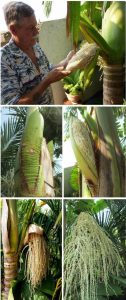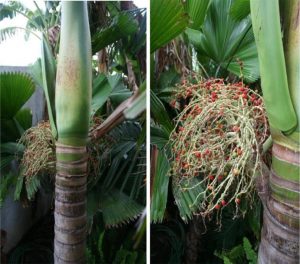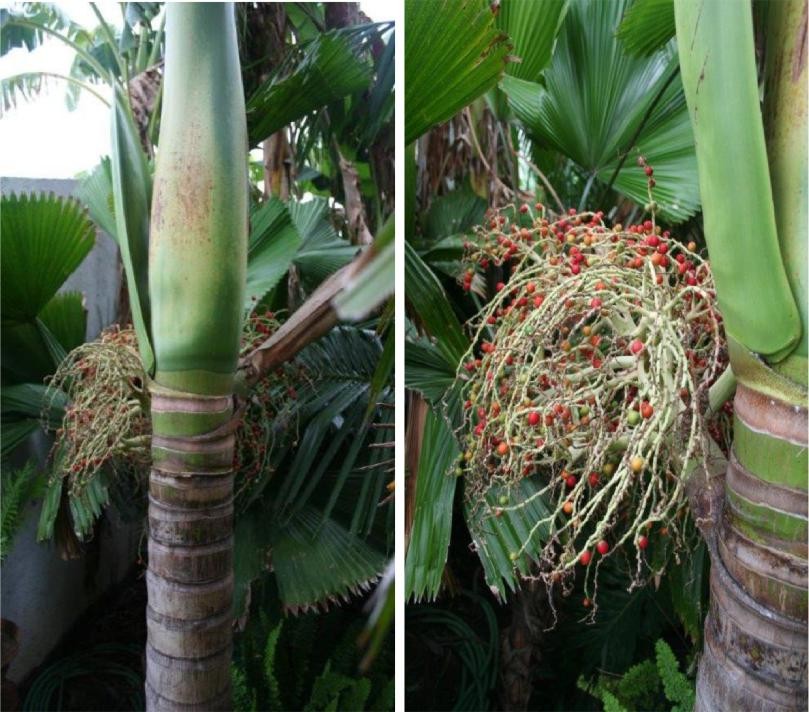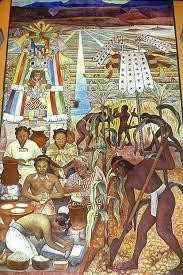By Tommy Clarkson from the February 2015 Edition
Archontophoenix alexandre
Family: Arecaceae
(Also known as Alexandra Palm, Alexandra King Palm, Alexander Palm, King Palm, Northern Bangalow Palm and the Alex Palm.)
As perhaps the foremost Guru of palm trees, Robert Lee Riffle, has stated, these “are some of the world’s most beautiful trees, palm or otherwise.”
Yet, that having been said, there are similar looking palms as they’re sometimes confused with the Solitaire Palm (Ptychosperma elegans) or the Hurricane Palm (Dictyosperma album). In fact, there are actually six species in this genus with all sharing the common name of King Palm.
The name for this species was derived from an honor bestowed upon Princess Alexandra of Denmark (18441925). It and its five relatives are tall and slender with unarmed feather leaf fronds which look quite similar to the fronds of a coconut palm frond while its trunk of the palm looks similar to the Manila (or Christmas) Palm.
Native to the coastal rainforest of northern Queensland to southeastern New South Wales in Australia, it is a single-trunked, self-cleaning and virtually maintenance free palm. In the wild it grows up to 18-25 meters (6080’) but it is more usually seen at a domesticated height of between six to nine meters (20-30’). In its native environs it often grows in lowland swamp forests but just to show that it’s not stuck in just one neighborhood, it can also be found happily living at altitudes up to 600 meters.
I’ve read that it is purported to be the fastest growing of all cultivated palms but in Ola Brisa Gardens I have several others that will certainly give it a run for its money in this category! It has a medium sized, ringed, light gray to olive-green straight trunk 30.5 to 46 cm (1-1.5’) in diameter with a slightly enlarged base topped with a bright green crownshaft composed of tightly wrapped pinnate leaf-bases. This, up to 90 cm (three feet) crownshaft is smooth and ranges in color form light green to purplish or a brownish red.
The Mount Lewis Palm (Archonotophoenix purpurea) is slightly different than its five siblings in that it has a crownshaft that is more bulbous at its base and is a reddish purple in color. Another of this genre, the Bangalow or Piccabeen Palm – and by some also called the King Palm – (archontophoenix cunninghamiana) displays lilac-purple flowers.
Its crown of eight to twelve large, graceful leaves, each 1.8 – 3 meters (six to ten feet) long and comprised of 100 or more closely spaced, narrow, drooping and strongly ribbed leaflets, is light green above and have a deep-green, grayish green, blue-green color or silver color on the underside. and, when mature can be six meters (20’) across. They grow from the rachis in a single plane with it twisting near its middle providing an absolutely wonderful angle for the leaf giving it – again in the words of Riffle – “a sense of movement even in still air.”
Its numerous white clusters on pendent spikes encircle the trunk

directly below the crownshaft sporting small white or nearly white unisexual (of both sexes) creamy-white flowers. These are followed by small, bright red fruits.
It works well as a single specimen landscape palm, nice when planted along streets or is quite pleasing in appearance when grouped with others. Sometimes planted in a tub they are effectively employed on verandas or patios. And, as a rainforest palm, it likes regular moisture and prefers a rich, deep, humusy, organic yet fast draining soil. It thrives in partial sun when young and but can handle full sun as a mature specimen.
As was my condition when but a tender, impressionable youth, its heart is vulnerable to fatal shattering. In the King Alexander Palm’s case, it may be when the crown is subjected to undue stress while being moved or transplanted. It is also susceptible to leaf-tip burn from drying winds.
One must not forget that it likes to be watered during the dry season and responds well to fertilization at least twice a year. So beyond drought, cold and drying winds are its enemies. The three things it likes: good air circulation, high relative humidity, and bright sunshine when no longer young. With such it will grow at least a vertical foot a year.
Long live the King!
Download the full edition or view it online
—
Tommy Clarkson is a bit of a renaissance man. He’s lived and worked in locales as disparate as the 1.2 square mile island of Kwajalein to war-torn Iraq, from aboard he and Patty’s boat berthed out of Sea Bright, NJ to Thailand, Germany, Hawaii and Viet Nam; He’s taught classes and courses on creative writing and mass communications from the elementary grades to graduate level; He’s spoken to a wide array of meetings, conferences and assemblages on topics as varied as Buddhism, strategic marketing and tropical plants; In the latter category he and Patty’s recently book, “The Civilized Jungle” – written for the lay gardener – has been heralded as “the best tropical plant book in the last ten years”; And, according to Trip Advisor, their spectacular tropical creation – Ola Brisa Gardens – is the “Number One Tour destination in Manzanillo”.





You must be logged in to post a comment.